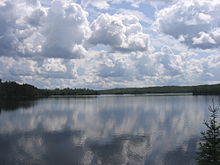International Joint Commission Commission mixte internationale | |
 | |
| Abbreviation |
|
|---|---|
| Formation | 11 January 1909 |
| Legal status | Active |
| Purpose | Approving projects that affect water, water levels, and flows across the boundary and investigating transboundary issues and recommending solutions |
| Headquarters | Ottawa, Ontario, Canada Washington, D.C., USA |
Official languages | English and French |
Chairperson (Canadian section) | Pierre Béland |
Chairperson (US section) | Gerald Acker |
| Website | ijc |

The International Joint Commission (French: Commission mixte internationale) is a bi-national organization established by the governments of the United States and Canada under the Boundary Waters Treaty of 1909. Its responsibilities were expanded with the signing of the Great Lakes Water Quality Agreement of 1972 (later amended 1987 and 2012).[1] The commission deals with issues affecting the extensive waters and waterways along the Canada–United States border.
A six member commission, it has multiple sub-commissions, which deal with particular sections of the border-waters, or topics, and a technical staff to organize and inform task-forces.
- ^ "Great Lakes Water Quality Agreement - 2012". Archived from the original on 5 April 2014. Retrieved 1 May 2014.
